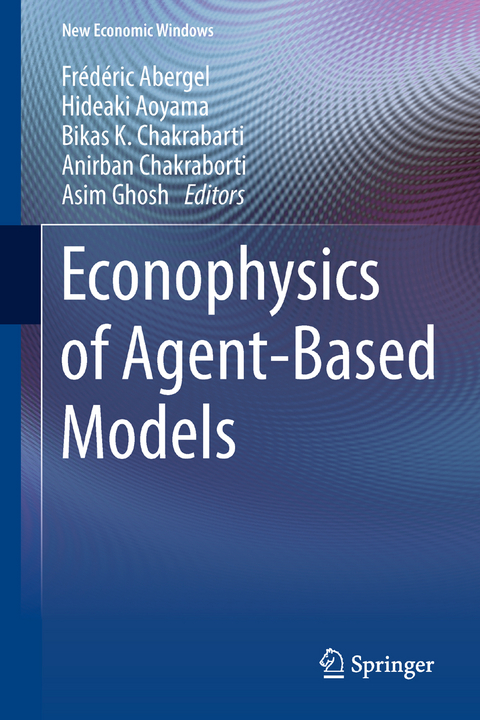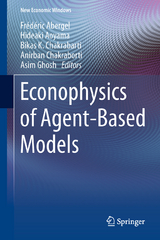Econophysics of Agent-Based Models
Springer International Publishing (Verlag)
978-3-319-00022-0 (ISBN)
The primary goal of this book is to present the research findings and conclusions of physicists, economists, mathematicians and financial engineers working in the field of "Econophysics" who have undertaken agent-based modelling, comparison with empirical studies and related investigations.
Most standard economic models assume the existence of the representative agent, who is "perfectly rational" and applies the utility maximization principle when taking action. One reason for this is the desire to keep models mathematically tractable: no tools are available to economists for solving non-linear models of heterogeneous adaptive agents without explicit optimization. In contrast, multi-agent models, which originated from statistical physics considerations, allow us to go beyond the prototype theories of traditional economics involving the representative agent. This book is based on the Econophys-Kolkata VII Workshop, at which many such modelling efforts were presented. In the book, leading researchers in their fields report on their latest work, consider recent developments and review the contemporary literature.
Anirban Chakraborti UrRL: http://fiquant.mas.ecp.fr/chakraboa Frédéric Abergel 1992 Habilitation à diriger des recherches, département de Mathématiques, Université Paris XI 1986 PhD in Mathematics, Université Paris XI and École Normale Supérieure 1981-1985 École Normale Supérieure Bikas K. Chakrabarti http://www.saha.ac.in/cmp/bikask.chakrabarti/bikas.html
Agent-based modeling of zapping behavior of viewers, television
commercial allocation, and advertisement markets by Hiroyuki Kyan and Jun-ichi Inoue.- Agent based modeling of Housing asset bubble: A simple utility function based investigation by Kausik Gangopadhyay and Kousik Guhathakurta.- Urn model-based adaptive Multi-arm clinical trials: A stochastic approximation approach by Sophie Laruelle and Gilles Pagès.- Logistic modeling of a Religious Sect features by Marcel Ausloos.- Characterizing financial crisis by means of the three states random field
Ising model by Mitsuaki Murota and Jun-ichi Inoue.- Themes and applications of kinetic exchange models: Redux by Asim Ghosh, Anindya S. Chakrabarti, Anjan Kumar Chandra and Anirban Chakraborti.- Kinetic exchange opinion model: solution in the single parameter map limit by Krishanu Roy Chowdhury, Asim Ghosh, Soumyajyoti Biswas and Bikas K.
Chakrabarti.- An overview of the new frontiers of Economic Complexity by Matthieu Cristelli, Andrea Tacchella, Luciano Pietronero.- Jan Tinbergen's legacy for economic networks: from the gravity model to quantum statistics by Tiziano Squartini and Diego Garlaschelli.- A macroscopic order of consumer demand due to heterogenous consumer behaviors on Japanese household demand tested by the random matrix theory by Yuji Aruka,Yuichi Kichikawa and Hiroshi Iyetomi.- Uncovering the network structure of the world currency market: Cross-correlations in the fluctuations of daily exchange rates by Sitabhra Sinha and Uday Kovur.- Systemic risk in Japanese credit network by Hideaki Aoyama.- Pricing of goods with Bandwagon properties: The curse of coordination by Mirta B. Gordon, Jean-Pierre Nadal, Denis Phan and Viktoriya Semeshenko.- Evolution of Econophysics by Kishore C. Dash.- Econophysics and sociophysics: Problems and prospects by Asim Ghosh and Anindya S. Chakrabarti.- A discussion on Econophysics by Hideaki Aoyama.
From the book reviews:
"The book is loosely divided into three sections. ... At their best, econophysics papers provide new insights into social science problems and new modeling technologies. ... I do think that agent-based modelers, particularly those who deal with others in the natural sciences from time to time, may find it a useful update on where this field is and where it is going. It does have something to say to those of us in this community." (Blake LeBaron, Journal of Economic Literature, Vol. 52 (3), September, 2014)| Erscheint lt. Verlag | 16.9.2013 |
|---|---|
| Reihe/Serie | New Economic Windows |
| Zusatzinfo | VIII, 302 p. 91 illus. |
| Verlagsort | Cham |
| Sprache | englisch |
| Maße | 155 x 235 mm |
| Gewicht | 637 g |
| Themenwelt | Mathematik / Informatik ► Informatik ► Theorie / Studium |
| Naturwissenschaften ► Physik / Astronomie ► Theoretische Physik | |
| Sozialwissenschaften ► Soziologie ► Empirische Sozialforschung | |
| Schlagworte | Agent based modelling • Agent-based Models • Complex Systems • Data-driven Science, Modeling and Theory Building • Econophysics Reviewed • Econophys-Kolkata VII • Multi-agent Modelling • multi-agent models |
| ISBN-10 | 3-319-00022-5 / 3319000225 |
| ISBN-13 | 978-3-319-00022-0 / 9783319000220 |
| Zustand | Neuware |
| Haben Sie eine Frage zum Produkt? |
aus dem Bereich




